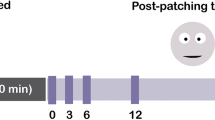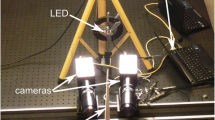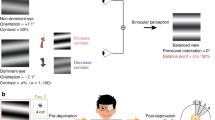Abstract
Background
This study sought to investigate whether eye dominance and age are related to the stimulus-free oculomotor resting state described via the dark disconjugate position (near or far), the dark conjugate position (left to right), and the near dissociated phoria.
Methods
Nineteen non-presbyopes and 25 presbyopes with normal binocular vision participated in two identical sessions. The left-eye and the right-eye positions were recorded using a video-based infrared eye tracker while the subjects were in total darkness. Dark disconjugate responses and dark conjugate responses were calculated by computing the difference and the average of the left-eye and the right-eye response, respectively. The right-eye decaying to the phoria level was recorded for 15 s.
Results
A one-way ANOVA assessed statistical differences in dark conjugate and dark disconjugate positions, comparing 1) the right-eye and the left-eye sensory and/or motor dominant groups and 2) the non-presbyope and presbyope groups. The test-retests of the dark disconjugate position, the dark conjugate position and the near dissociated heterophoria were high between sessions (r > 0.85; p < 0.00001). For non-presbyopes the right-eye (left-eye) motor and sensory dominant subjects showed a rightward (leftward) dark conjugate position (p < 0.01). The dark disconjugate position was receded in presbyopes compared to non-presbyopes (p < 0.0001).
Conclusion
The data support that the left-eye, or the right-eye, motor and sensory dominance predicts the direction of the dark conjugate position. Future studies could investigate the underlying neural substrates that may, in part, contribute to the resting state of the oculomotor system in a stimulus-free environment. Knowledge of the brain-behavior governing visual-field preference has implications for understanding the natural aging process of the visual system.





Similar content being viewed by others
References
Ogle KN (1964) Researches in binocular vision. Hafner, New York, pp 50–55
Coren S, Kaplan CP (1973) Patterns of ocular dominance. Am J Optom Arch Am Acad Optom 50:283–292
Coren S, Porac C (1976) Size accentuation in the dominant eye. Nature 260:527–528
Li J, Lam CS, Yu M, Hess RF, Chan LY, Maehara G, Woo GC, Thompson B (2010) Quantifying sensory eye dominance in the normal visual system: a new technique and insights into variation across traditional tests. Invest Ophthalmol Vis Sci 51:6875–6881
Barbeito R (1981) Sighting dominance: an explanation based on the processing of visual direction in tests of sighting dominance. Vis Res 21:855–860
Miles WR (1930) Ocular dominance in human adults. J Gen Psychol 3:412–420
Ono H, Barbeito R (1982) The cyclopean eye vs. the sighting-dominant eye as the center of visual direction. Percept Psychophys 32:201–210
Mapp AP, Ono H, Barbeito R (2003) What does the dominant eye dominate? A brief and somewhat contentious review. Percept Psychophys 65:310–317
Porta JB (1593) De refractione optices parte: Libri novem. Carlinum and Pacem, Naples
Handa T, Mukuno K, Uozato H, Niida T, Shoji N, Minei R, Nitta M, Shimizu K (2004) Ocular dominance and patient satisfaction after monovision induced by intraocular lens implantation. J Cataract Refract Surg 30:769–774
Handa T, Mukuno K, Uozato H, Niida T, Shoji N, Shimizu K (2004) Effects of dominant and nondominant eyes in binocular rivalry. Optom Vis Sci 81:377–383
Romano PE (1988) Ocular dominance tests before cataract surgery, especially monocular or unilateral. Ophthalmology 95:856
Seijas O, Gomez De Liano P, Gomez De Liano R, Roberts CJ, Piedrahita E, Diaz E (2007) Ocular dominance diagnosis and its influence in monovision. Am J Ophthalmol 144:209–216
Westin E, Wick B, Harrist RB (2000) Factors influencing success of monovision contact lens fitting: survey of contact lens diplomates. Optometry 71:757–763
Linke SJ, Baviera J, Munzer G, Steinberg J, Richard G, Katz T (2011) Association between ocular dominance and spherical/astigmatic anisometropia, age, and sex: analysis of 10,264 myopic individuals. Invest Ophthalmol Vis Sci 52:9166–9173
Linke SJ, Baviera J, Richard G, Katz T (2012) Association between ocular dominance and spherical/astigmatic anisometropia, Age and Sex: analysis of 1274 hyperopic individuals. Invest Ophthalmol Vis Sci 53:5362–5369
Mendola JD, Conner IP (2007) Eye dominance predicts fMRI signals in human retinotopic cortex. Neurosci Lett 414:30–34
Rombouts SA, Barkhof F, Sprenger M, Valk J, Scheltens P (1996) The functional basis of ocular dominance: functional MRI (fMRI) findings. Neurosci Lett 221:1–4
Seyal M, Sato S, White BG, Porter RJ (1981) Visual evoked potentials and eye dominance. Electroencephalogr Clin Neurophysiol 52:424–428
Taghavy A, Kugler CF (1987) Pattern reversal visual evoked potentials (white-black- and colour-black-PVEPs) in the study of eye dominance. Eur Arch Psychiatr Neurol Sci 236:329–332
Ibi K (1997) Characteristics of dynamic accommodation responses: comparison between the dominant and non-dominant eyes. Ophthalmic Physiol Opt 17:44–54
Kawata H, Ohtsuka K (2001) Dynamic asymmetries in convergence eye movements under natural viewing conditions. Jpn J Ophthalmol 45:437–444
Oishi A, Tobimatsu S, Arakawa K, Taniwaki T, Kira J (2005) Ocular dominancy in conjugate eye movements at reading distance. Neurosci Res 52:263–268
Van Leeuwen AF, Collewijn H, Erkelens CJ (1998) Dynamics of horizontal vergence movements: interaction with horizontal and vertical saccades and relation with monocular preferences. Vis Res 38:3943–3954
Rosenfield M (1997) Tonic vergence and vergence adaptation. Optom Vis Sci 74:303–328
Han SJ, Guo Y, Granger-Donetti B, Vicci VR, Alvarez TL (2010) Quantification of heterophoria and phoria adaptation using an automated objective system compared to clinical methods. Ophthalmic Physiol Opt 30:95–107
Jaschinski W, Jainta S, Hoormann J, Walper N (2007) Objective vs subjective measurements of dark vergence. Ophthalmic Physiol Opt 27:85–92
Kim EH, Alvarez TL (2012) The changes in phoria and convergence to divergence peak velocity ratio are correlated. Curr Eye Res 37:1054–1065
Kim EH, Granger-Donetti B, Vicci VR, Alvarez TL (2010) The relationship between phoria and the ratio of convergence peak velocity to divergence peak velocity. Invest Ophthalmol Vis Sci 51:4017–4027
Kim EH, Vicci VR, Granger-Donetti B, Alvarez TL (2011) Short-term adaptations of the dynamic disparity vergence and phoria systems. Exp Brain Res 212:267–278
Lee YY, Granger-Donetti B, Chang C, Alvarez TL (2009) Sustained convergence induced changes in phoria and divergence dynamics. Vis Res 49:2960–2972
Jaschinski W (2001) Fixation disparity and accommodation for stimuli closer and more distant than oculomotor tonic positions. Vis Res 41:923–933
Schor CM, Kotulak JC, Tsuetaki T (1986) Adaptation of tonic accommodation reduces accommodative lag and is masked in darkness. Invest Ophthalmol Vis Sci 27:820–827
Freier BE, Pickwell LD (1983) Physiological exophoria. Ophthalmic Physiol Opt 3:267–272
Yekta AA, Pickwell LD, Jenkins TC (1989) Binocular vision, age and symptoms. Ophthalmic Physiol Opt 9:115–120
Mcdonnell PJ, Lee P, Spritzer K, Lindblad AS, Hays RD (2003) Associations of presbyopia with vision-targeted health-related quality of life. Arch Ophthalmol 121:1577–1581
Alvarez TL, Vicci VR, Alkan Y, Kim EH, Gohel S, Barrett AM, Chiaravalloti N, Biswal BB (2010) Vision therapy in adults with convergence insufficiency: clinical and functional magnetic resonance imaging measures. Optom Vis Sci 87:E985–E1002
Scheiman M, Gallaway M, Frantz KA, Peters RJ, Hatch S, Cuff M, Mitchell GL (2003) Nearpoint of convergence: test procedure, target selection, and normative data. Optom Vis Sci 80:214–225
Benjamin W, Borish I (1998) Borish’s Clinical refraction. Saunders, Philadelphia, pp 559–628
Grosvenor T (2007) Primary care optometry. Butterworth-Heinemann, Boston, pp 13–16
Krantz EM, Cruickshanks KJ, Klein BE, Klein R, Huang GH, Nieto FJ (2010) Measuring refraction in adults in epidemiological studies. Arch Ophthalmol 128:88–92
Khojasteh E, Galiana HL (2007) Modulation of vergence during the vestibulo-ocular reflex. Conf Proc IEEE Eng Med Biol Soc 2007:5377–5380
Guo Y, Kim EH, Alvarez TL (2011) VisualEyes: a modular software system for oculomotor experimentation. J Vis Exp. e2530
Rambold H, Neumann G, Sander T, Helmchen C (2006) Age-related changes of vergence under natural viewing conditions. Neurobiol Aging 27:163–172
Meijering E (2002) A chronology of interpolation: from ancient astronomy to modern signal and image processing. Proc IEEE 90:319–342
Chen Y-F, Lee YY, Chen T, Semmlow JL, Alvarez TL (2010) Behaviors, models and clinical applications of vergence eye movements. J Med Biol Eng 3:1–15
Semmlow JL, Alvarez TL, Granger-Donetti B (2012) Error correction in vergence eye movements: evidence supporting Hering’s Law. J Eye Mov Res 5:1–9
Semmlow JL, Alvarez TL, Pedrono C (2007) Dry dissection of disparity divergence eye movements using independent component analysis. Comput Biol Med 37:910–918
Semmlow JL, Chen Y-F, Pedrono C, Alvarez TL (2008) Saccadic behavior during the response to pure disparity vergence stimuli I: general properties. J Eye Mov Res 1:1–11
Kim EH, Vicci VR, Han SJ, Alvarez TL (2011) Sustained fixation induced changes in phoria and convergence peak velocity. PLoS One 6:e20883
Lenth R (2006) Java Applets for Power and Sample Size [Computer software]. Available: http://www.stat.uiowa.edu/~rlenth/Power accessed on March 8, 2013
Runger M (2007) Probability and statistics. Wiley and Sons, Hoboken
Mcginty SJ, Truscott RJ (2006) Presbyopia: the first stage of nuclear cataract? Ophthalmic Res 38:137–148
Schachar RA, Chan RW, Fu M (2011) Viscoelastic properties of fresh human lenses under 40 years of age: implications for the aetiology of presbyopia. Br J Ophthalmol 95:1010–1013
Sheppard AL, Davies LN (2011) The effect of ageing on in vivo human ciliary muscle morphology and contractility. Invest Ophthalmol Vis Sci 52:1809–1816
Charman WN (2008) The eye in focus: accommodation and presbyopia. Clin Exp Optom 91:207–225
Roth HL, Lora AN, Heilman KM (2002) Effects of monocular viewing and eye dominance on spatial attention. Brain 125:2023–2035
Weiss PH, Marshall JC, Wunderlich G, Tellmann L, Halligan PW, Freund HJ, Zilles K, Fink GR (2000) Neural consequences of acting in near versus far space: a physiological basis for clinical dissociations. Brain 123(Pt 12):2531–2541
Cabeza R (2002) Hemispheric asymmetry reduction in older adults: the HAROLD model. Psychol Aging 17:85–100
Cabeza R, Daselaar SM, Dolcos F, Prince SE, Budde M, Nyberg L (2004) Task-independent and task-specific age effects on brain activity during working memory, visual attention and episodic retrieval. Cereb Cortex 14:364–375
Dolcos F, Rice HJ, Cabeza R (2002) Hemispheric asymmetry and aging: right hemisphere decline or asymmetry reduction. Neurosci Biobehav Rev 26:819–825
Madden DJ (2007) Aging and visual attention. Curr Dir Psychol Sci 16:70–74
Kommerell G, Schmitt C, Kromeier M, Bach M (2003) Ocular prevalence versus ocular dominance. Vis Res 43:1397–1403
Suttle C, Alexander J, Liu M, Ng S, Poon J, Tran T (2009) Sensory ocular dominance based on resolution acuity, contrast sensitivity and alignment sensitivity. Clin Exp Optom 92:2–8
Post RB, Caufield KJ, Welch RB (2001) Contributions of object- and space-based mechanisms to line bisection errors. Neuropsychologia 39:856–864
Heilman KM (1979) Neglect and related disorders. Oxford University Press, New York
Mesulam MM (1999) Spatial attention and neglect: parietal, frontal and cingulate contributions to the mental representation and attentional targeting of salient extrapersonal events. Philos Trans Roy Soc Lond B Biol Sci 354:1325–1346
Becker E, Karnath HO (2010) Neuroimaging of eye position reveals spatial neglect. Brain 133:909–914
Marx E, Deutschlander A, Stephan T, Dieterich M, Wiesmann M, Brandt T (2004) Eyes open and eyes closed as rest conditions: impact on brain activation patterns. NeuroImage 21:1818–1824
Marx E, Stephan T, Nolte A, Deutschlander A, Seelos KC, Dieterich M, Brandt T (2003) Eye closure in darkness animates sensory systems. NeuroImage 19:924–934
Dowley D (1987) The orthophorization of heterophoria. Ophthalmic Physiol Opt 7:169–174
Dowley D (1990) Heterophoria. Optom Vis Sci 67:456–460
Radakovic M, Ivetic V, Naumovic N, Canadanovic V, Stankov B (2012) Heterophoria and fusional convergence and divergence in preschool children. Med Glas (Zenica) 9:293–298
Anderson H, Stuebing KK, Fern KD, Manny RE (2011) Ten-year changes in fusional vergence, phoria, and nearpoint of convergence in myopic children. Optom Vis Sci 88:1060–1065
Author information
Authors and Affiliations
Corresponding author
Additional information
Grants
This research was supported in part by NSF MRI CBET1228254 to TLA.
Rights and permissions
About this article
Cite this article
Kim, E.H., Alvarez, T.L. The horizontal dark oculomotor rest position. Graefes Arch Clin Exp Ophthalmol 251, 2119–2130 (2013). https://doi.org/10.1007/s00417-013-2379-3
Received:
Revised:
Accepted:
Published:
Issue Date:
DOI: https://doi.org/10.1007/s00417-013-2379-3




